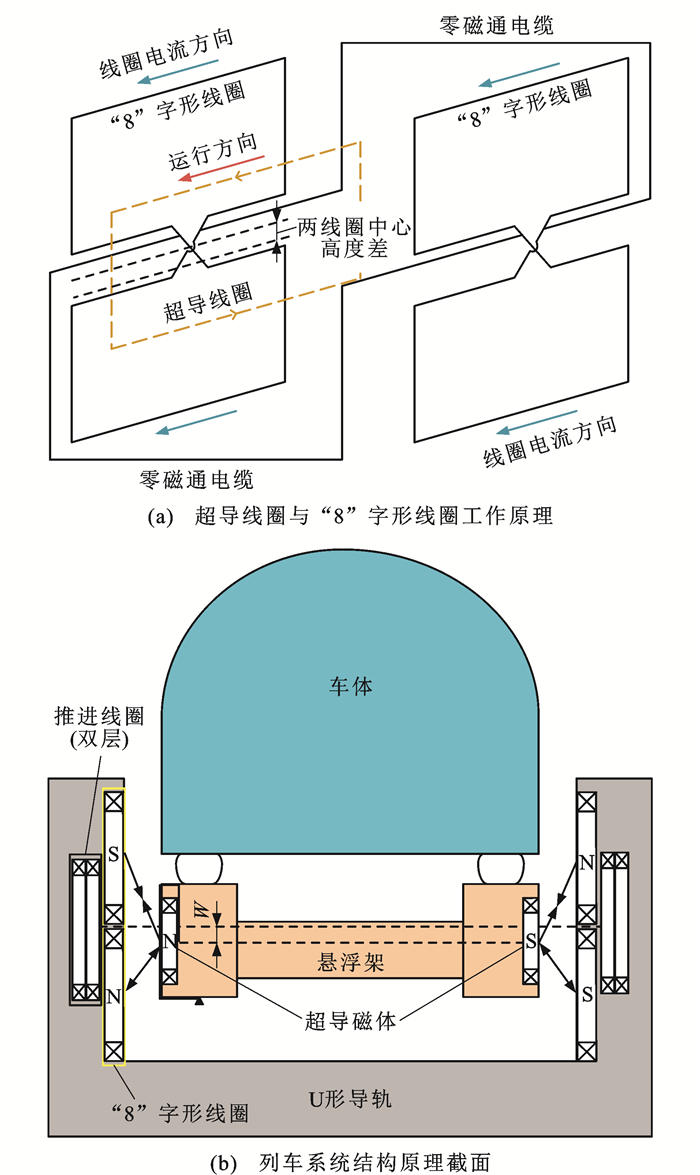Optimization on multi-stage suspension scheme and dynamics performance of superconducting EDS maglev train
-
摘要: 研究了超导电动悬浮(EDS)磁浮列车悬浮架的悬挂方案,分析了超导EDS磁浮列车的工作原理和既有悬浮架的悬挂系统技术特征,提出了一种多级悬挂系统优化方案,从理论上推导了多级悬挂车辆的动力学微分方程;基于多体动力学软件SIMPACK与数学工具MATLAB/Simulink搭建了超导EDS磁浮列车动力学联合仿真框架,分析了超导EDS系统的磁力特性;将计算得到的电磁力组建成一个查找表,利用SIMPACK分别构建了既有悬挂方案和多级悬挂方案下3车体和4悬浮架的三编组超导EDS磁浮列车机械模型,借助MATLAB/Simulink建立了电磁力查找模型,通过SIMAT模块将查找表与机械动力学模型耦合,并通过联合仿真对比了在轨道随机不平顺条件下不同悬挂方案的超导EDS磁浮列车动力学响应。研究结果表明:与既有方案相比,采用多级悬挂方案时列车悬浮架和车体的振动响应明显减小,二者振动加速度峰值降幅均达到50%以上,车体振动加速度均小于1 m·s-2,车体各向平稳性指标基本保持在2.5以下的优秀水平,证明采用多级悬挂方案可以改善列车运行时的动力响应,提高车辆整体的乘坐舒适性。研究工作可为超导EDS磁浮列车的悬浮架方案优化设计和动力学研究提供理论依据和参考。Abstract: The suspension scheme of the superconducting electrodynamic suspension (EDS) maglev train levitation bogie was studied. The working principles of the superconducting EDS maglev train and the technical characteristics of the suspension system of existing levitation bogie were analyzed, and a multi-stage suspension system optimization scheme was proposed. The dynamics differential equation of the multi-stage suspension vehicle was theoretically derived. A co-simulation framework of superconducting EDS maglev train dynamics was established based on the multi-body dynamics software SIMPACK and the mathematical tool MATLAB/Simulink, and the magnetic properties of the superconducting EDS system were analyzed. The calculated electromagnetic forces were formed into a search table, and the mechanical models of three train bodies and four levitation bogies of the three-group superconducting EDS maglev train were constructed under the existing suspension scheme and multi-stage suspension scheme by SIMPACK. The electromagnetic force search model was established though MATLAB/Simulink. The search table was coupled with the mechanical dynamics model through the SIMAT module, and the dynamics responses of the superconducting EDS maglev trains under different suspension schemes in the condition of random track irregularity were compared though the co-simulation. Research results show that compared with the existing scheme, the vibration responses of the train levitation bogie and train body significantly reduce when the multi-stage suspension scheme is adopted, and the peak vibration acceleration amplitudes of both reduce by more than 50%. The vibration accelerations of the train bodies are both less than 1 m·s-2, and the stability indexes are basically maintained at an excellent level below 2.5. It is proved that the multi-stage suspension scheme can improve the dynamic response of the train and enhance the overall ride comfort of the vehicle. The research can provide a theoretical basis and reference for the optimization design of the levitation bogie scheme and dynamics research of the superconducting EDS maglev train. 1 tab, 11 figs, 31 refs.
-
表 1 建模参数
Table 1. Modeling parameters
参数 数值 端车车体质量/kg 2.055×104 中间车车体质量/kg 1.37×104 悬浮架质量/kg 6.3×103 超导磁体质量/kg 2.8×103 悬浮架长度/m 5.4 悬浮点横向间距(轨距)/m 2.98 悬浮架质心纵向间距/m 21.6 车体质心纵向间距/m 25.875 超导线圈极距/m 1.35 二系空簧垂向刚度/(N·m-1) 1.96×105 二系空簧横向刚度/(N·m-1) 2.25×105 二系空簧垂向阻尼/(N·s·m-1) 2.45×103 二系空簧横向阻尼/(N·s·m-1) 1.47×104 一系橡胶弹簧纵向刚度/(N·m-1) 4.60×106 一系橡胶弹簧横向刚度/(N·m-1) 3.34×106 一系橡胶弹簧垂向刚度/(N·m-1) 2.33×106 一系橡胶弹簧阻尼/(N·m-1) 3.00×103 -
[1] 熊嘉阳, 邓自刚. 高速磁悬浮轨道交通研究进展[J]. 交通运输工程学报, 2021, 21(1): 177-198. doi: 10.19818/j.cnki.1671-1637.2021.01.008XIONG Jia-yang, DENG Zi-gang. Research progress of high-speed maglev rail transit[J]. Journal of Traffic and Transportation Engineering, 2021, 21(1): 177-198. (in Chinese) doi: 10.19818/j.cnki.1671-1637.2021.01.008 [2] 徐飞, 罗世辉, 邓自刚. 磁悬浮轨道交通关键技术及全速度域应用研究[J]. 铁道学报, 2019, 41(3): 40-49. doi: 10.3969/j.issn.1001-8360.2019.03.006XU Fei, LUO Shi-hui, DENG Zi-gang. Study on key technologies and whole speed range application of maglev rail transport[J]. Journal of the China Railway Society, 2019, 41(3): 40-49. (in Chinese) doi: 10.3969/j.issn.1001-8360.2019.03.006 [3] 余浩伟, 寇峻瑜, 李艳. 600 km·h-1高速磁浮在国内的适应性及工程化发展[J]. 铁道工程学报, 2020, 37(12): 16-20, 88.YU Hao-wei, KOU Jun-yu, LI Yan. Adaptability and engineering development of 600 km·h-1 high-speed maglev in China[J]. Journal of Railway Engineering Society, 2020, 37(12): 16-20, 88. (in Chinese) [4] 熊嘉阳, 沈志云. 中国高速铁路的崛起和今后的发展[J]. 交通运输工程学报, 2021, 21(5): 6-29. doi: 10.19818/j.cnki.1671-1637.2021.05.002XIONG Jia-yang, SHEN Zhi-yun. Rise and future development of Chinese high-speed railway[J]. Journal of Traffic and Transportation Engineering, 2021, 21(5): 6-29. (in Chinese) doi: 10.19818/j.cnki.1671-1637.2021.05.002 [5] 王一宇, 蔡尧, 宋旭亮, 等. 零磁通式电动悬浮等效模拟系统的特性分析与实验[J]. 电工技术学报, 2021, 36(8): 1628-1635.WANG Yi-yu, CAI Yao, SONG Xu-liang, et al. Characteristic analysis and experiment of the equivalent simulation system for null-flux electrodynamic suspension[J]. Transactions of China Electrotechnical Society, 2021, 36(8): 1628-1635. (in Chinese) [6] 马卫华, 罗世辉, 张敏, 等. 中低速磁浮车辆研究综述[J]. 交通运输工程学报, 2021, 21(1): 199-216. doi: 10.19818/j.cnki.1671-1637.2021.01.009MA Wei-hua, LUO Shi-hui, ZHANG Min, et al. Research review on medium and low speed maglev vehicle[J]. Journal of Traffic and Transportation Engineering, 2021, 21(1): 199-216. (in Chinese) doi: 10.19818/j.cnki.1671-1637.2021.01.009 [7] 舒信伟, 谷传纲, 梁习锋, 等. 高速磁浮列车气动阻力性能数值模拟与参数化评估[J]. 交通运输工程学报, 2006, 6(2): 6-10.SHU Xin-wei, GU Chuan-gang, LIANG Xi-feng, et al. Numerical simulation and parameterized investigation of aerodynamic drag performances of high-speed maglev trains[J]. Journal of Traffic and Transportation Engineering, 2006, 6(2): 6-10. (in Chinese) [8] ROTE D M, CAI Yi-gang. Review of dynamic stability of repulsive-force maglev suspension systems[J]. IEEE Transactions on Magnetics, 2002, 38(2): 1383-1390. doi: 10.1109/20.996030 [9] HOSHINO H, SUZUKI E, WATANABE K. Reduction of vibrations in maglev vehicles using active primary and secondary suspension control[J]. Quarterly Report of RTRI, 2008, 49(2): 113-118. doi: 10.2219/rtriqr.49.113 [10] WATANABE K, YOSHIOKA H, SUZUKI E. Combined control of primary and secondary suspension of maglev vehicles[J]. Quarterly Report of RTRI, 2004, 45(1): 26-31. doi: 10.2219/rtriqr.45.26 [11] WATANABE K, YOSHIOKA H, SUZUKI E, et al. A study of vibration control systems for superconducting maglev vehicles (vibration control of lateral and rolling motions)[J]. Journal of System Design and Dynamics, 2007, 1(3): 593-604. doi: 10.1299/jsdd.1.593 [12] WATANABE K, YOSHIOKA H, WATANABE E, et al. A study of the vibration control system for a superconducting maglev vehicle[C]//J-STAGE. The Proceedings of the International Conference on Motion and Vibration Control. Tokyo: J-STAGE, 2002: 907-912. [13] EARLY R, ABE Y, OHSAKI H. Numerical analysis of the vehicle dynamics of the superconducting maglev system at the Yamanashi Test Line[C]//MAGLEV. Proceeding of 17th International Conference on Magnetically Levitated Systems and Linear Drives. Dresden: MAGLEV, 2002: 1-10. [14] OHSAKI H, BANDO S. Numerical analysis of elastic vibration of superconducting maglev vehicles[C]//MAGLEV. Proceeding of 19th International Conference on Magnetically Levitated Systems and Linear Drives. Dresden: MAGLEV, 2006: 1-6. [15] HOSHINO H, SUZUKI E, YONEZU T, et al. Examination of vehicle motion characteristics of a maglev train set using a reduced-scale model experiment apparatus[J]. Quarterly Report of RTRI, 2012, 53(1): 52-58. doi: 10.2219/rtriqr.53.52 [16] HA H, PARK K S. Construction of simulation framework for dynamic analysis of a superconducting magnetic levitation train with flexible car bodies[J]. Journal of Mechanical Science and Technology, 2019, 33(3): 1177-1183. doi: 10.1007/s12206-019-0217-1 [17] YOSHIOKA H. 山梨磁悬浮试验线车辆MLX01的动力学性能[J]. 国外铁道车辆, 2000, 37(5): 27-32.YOSHIOKA H. Dynamic performance of MLX01 car on Yamanashi Magnetic Levitation Test Line[J]. Foreign Rolling Stock, 2000, 37(5): 27-32. (in Chinese) [18] OHASHI S. Effect of the damper coils on the guideway displacement in the superconducting magnetically levitated bogie[J]. IEEE Transactions on Applied Superconductivity, 2012, 22(3): 3600604. doi: 10.1109/TASC.2012.2186624 [19] OHASHI S. Effect of the active damper coils of the superconducting magnetically levitated bogie in case of acceleration[J]. IEEE Transactions on Magnetics, 2008, 44(11): 4163-4166. doi: 10.1109/TMAG.2008.2002788 [20] OHASHI S, UESHIMA T. Control method of the semi-active damper coil system in the superconducting magnetically levitated bogie against vertical and pitching oscillation[J]. IEEE Transactions on Magnetics, 2012, 48(11): 4542-4545. doi: 10.1109/TMAG.2012.2202378 [21] OHASHI S, OHSAKI H, MASADA E. Effect of the active damper coil system on the lateral displacement of the magnetically levitated bogie[J]. IEEE Transactions on Magnetics, 1999, 35(5): 4001-4003. doi: 10.1109/20.800735 [22] YONEZU T, WATANABE K, SUZUKI E, et al. Characteristics of magnetic springs for guidance of superconducting maglev vehicles[J]. Quarterly Report of RTRI, 2018, 59(4): 293-298. doi: 10.2219/rtriqr.59.4_293 [23] HAN H S, KIM D S. Magnetic Levitation-Maglev Technology and Applications[M]. Berlin: Springer, 2016. [24] 李志强, 李亨利, 缪惠勇. 新型轴箱橡胶弹簧的研制[J]. 铁道车辆, 2011, 49(4): 12-14, 47.LI Zhi-qiang, LI Heng-li, MIAO Hui-yong. Development of new type axle box rubber springs[J]. Rolling Stock, 2011, 49(4): 12-14, 47. (in Chinese) [25] YAN Zhao-ying, MA Guang-tong, ZHANG Wei-hai, et al. Dynamic response of a superconducting EDS train with vehicle/guideway coupled dynamics[J]. IEEE Transactions on Applied Superconductivity, 2020, 30(4): 1-5. [26] HE J L, ROTE D M, COFFEY H T. Applications of the dynamic circuit theory to maglev suspension systems[J]. IEEE Transactions on Magnetics, 1993, 29(6): 4153-4164. doi: 10.1109/20.280868 [27] SONG M K, KIM K H. Development of dynamic analysis system for guideway structures by considering ultra high-speed maglev train-guideway interaction[J]. Journal of the Korean Society of Civil Engineers, 2005, https://www.researchgate.net/publication/264143704. https://www.researchgate.net/publication/264143704 [28] OHASHI S, OHSAKI H, MASADA E. Running characteristics of the superconducting magnetically levitated train in the case of superconducting coil quenching[J]. Electrical Engineering in Japan, 2000, 130(1): 95-105. doi: 10.1002/(SICI)1520-6416(200001)130:1<95::AID-EEJ12>3.0.CO;2-I [29] SHI Yan, MA Wei-hua, LI Miao, et al. Research on dynamics of a new high speed maglev vehicle[J]. Vehicle System Dynamics, 2022, 60(3): 721-742. doi: 10.1080/00423114.2020.1838568 [30] NISHIKAWA Y, IGARASHI M, KUSADA S. Development of new-type superconducting magnets for the superconducting maglev[C]//MAGLEV. Proceeding of 19th International Conference on Magnetically Levitated Systems and Linear Drives. Dresden: MAGLEV, 2016: 7-12. [31] 赵春发, 翟婉明. 磁浮车辆/轨道系统动力学(Ⅱ)——建模与仿真[J]. 机械工程学报, 2005, 41(8): 163-175.ZHAO Chun-fa, ZHAI Wan-ming. Dynamics of maglev vehicle/guideway systems (Ⅱ)—modeling and simulation[J]. Chinese Journal of Mechanical Engineering, 2005, 41(8): 163-175. (in Chinese) -





 下载:
下载:












